In recent weeks, many PBS stations aired Ken Burns’s latest film, a six-part series called The National Parks: America’s Best Idea. The documentary chronicles the rise of the park concept and the often dramatic struggles to preserve—for the benefit and enjoyment of the people—some of the country’s most spectacular scenery. The National Parks devotes significant attention to the ways in which both naturalists and ordinary people have responded to nature and the parks over time, which inspired me to think about the sizable group of paintings in American Stories that feature figures in landscape settings. In fact, I was struck by how much the paintings resonate with the same ideas about the American wilderness that are brought out in the documentary.
It’s worth a brief interruption to mention that paintings of pure landscape, such as those by the artists of the Hudson River School, are absent from the exhibition. To be sure, landscapes can and do tell stories—sometimes truly extraordinary ones—but the works included in American Stories focus on figures and the everyday human dramas in which they participate.
One of the most extraordinary paintings of ordinary life in the exhibition is George Caleb Bingham’s Fur Traders Descending the Missouri, seen here:
Above: George Caleb Bingham (American, 1811–1879). Fur Traders Descending the Missouri, 1845. Oil on canvas; 29 x 36 1/2 in. (73.7 x 92.7 cm). The Metropolitan Museum of Art, New York, Morris K. Jesup Fund, 1933 (33.61). Photograph © The Metropolitan Museum of Art.
The rugged father-and-son team, accompanied by a bear cub, are in tune with and reliant on nature, floating down a river past a calm and pristine landscape that is unmarred by signs of development, or even of other people. By 1845, the year that George Caleb Bingham finished and exhibited this painting, the simple way of life he depicted had already begun to disappear in the wake of increasing development and industrialization. Calls for federal protection of American lands began as early as the 1830s, and Bingham was no doubt keenly aware of the nostalgia that urban Easterners—his target audience—felt for the rapidly vanishing frontier. (This nostalgia also provided additional support for the burgeoning conservation movement, as The National Parks points out.) In the same way that Bingham cast a longing glance backward, freezing a moment in time, proponents of protected natural reserves strove to halt the encroachment of industrial development on scenic tracts of land.
William Sidney Mount’s Eel Spearing at Setauket is, like Bingham’s painting, a view of “the good old days.” In this case, the painting was created to appeal to a specific patron’s nostalgia for his childhood:
Above: William Sidney Mount (American, 1807–1868). Eel Spearing at Setauket, 1845. Oil on canvas; 28 1/2 x 36 in. (72.4 x 91.4 cm). Fenimore Art Museum, Cooperstown, New York (N-395.55). Photograph: Richard Walker.
This scene of figures fishing off the shore of Long Island was commissioned by George Washington Strong, a wealthy lawyer who had spent his boyhood near the island’s north coast. Mount also grew up in Long Island and likely shared his patron’s wistful feelings about this particular scene. But as we know from his writing, the artist sought to communicate something more than just nostalgia in his paintings. In a diary entry from the mid-1840s, Mount wrote:
There has been enough written on ideality—and the grand style of Art etc—to divert the artist from the study of natural objects. For ever after, let me read the volume of nature—a lecture always ready and bound by the Almighty.
In the same way that the boy in Mount’s painting learns the ways of nature from an adult companion, we may imagine that the artist is seeking to understand the presence of the divine in the stillness and serenity of nature. The Emersonian concept of finding God in the outdoors was pervasive in the nineteenth century, and, as The National Parks tells us, fueled the notion that nature is restorative. The film presents Stephen Mather, the first National Park Service director, as a striking example of someone who warded off debilitating bouts of depression by spending time out of doors.
In American Stories, figures enjoying the restorative powers of nature can be seen in works by William Merritt Chase and Thomas Eakins:
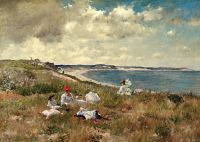 |
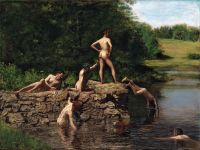 |
Above, from left to right: William Merritt Chase (American, 1849–1916). Idle Hours, ca. 1894. Oil on canvas; 39 x 48 5/8 in. (99.1 x 123.5 cm). Amon Carter Museum, Fort Worth, Texas (1982.1); Thomas Eakins (American, 1844–1916). Swimming, 1885. Oil on canvas; 27 3/8 x 36 3/8 in. (69.5 x 92.4 cm). Amon Carter Museum, Fort Worth, Texas, Purchased by the Friends of Art, Fort Worth Art Association, 1925; acquired by the Amon Carter Museum, 1990, from the Modern Art Museum of Fort Worth through grants and donations from the Amon G. Carter Foundation, the Sid W. Richardson Foundation, the Anne Burnett and Charles Tandy Foundation, Capital Cities/ABC Foundation, Fort Worth Star-Telegram, The R. D. and Joan Dale Hubbard Foundation, and the people of Fort Worth (1990.19.1).
Chase’s painting depicts members of his family relaxing by the seaside in Southampton, Long Island. Although the family lived most of the year in New York City, they retreated to the countryside during the summers while the artist taught at the Shinnecock Hills Summer School of Art. The landscape in Chase’s painting is not a national park, but the figures—especially the girl in the blue dress sprawled across the grass—seem to enjoy the same sense of relief from the stresses of urban life that visitors to Yellowstone and Yosemite might. Similarly, Eakins’s swimmers, who have retreated from the city of Philadelphia to the countryside, enjoy a moment of outdoor leisure. Their nakedness also suggests that they’ve recovered in nature an elemental part of their humanity that’s not accessible to them in urban society.
In addition to the nostalgia and restorative properties associated with nature, The National Parks describes the hold that the wilderness has on the American imagination. In 1871, readers of Scribner’s Monthly were captivated by Truman C. Everts’s serialized account of being stranded in Yellowstone for thirty-seven days and surviving encounters with a mountain lion, a snowstorm, and burns from the steam of a hot spring. In the 1880s, inspired by the park’s geysers and boiling mud pots, and taking advantage of the popularity of Lewis Carroll’s Alice books, railroad companies marketed Yellowstone as a “New Wonderland.” (See the Southern Methodist University website to learn more about one of the brochures featured in National Parks.)
Several paintings in American Stories, including Frederic Remington’s Fight for the Water Hole, demonstrate the power of landscape to capture the imagination. In this work and others, the artist appealed to Easterners’ fantasies about rugged life in the West, shaping ideas about the frontier experience that would go on to inspire John Ford and other directors of early Western movies. Consider also these two paintings in the exhibition, which depict figures who are entranced by their natural surroundings:
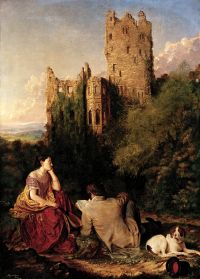 |
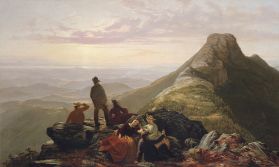 |
Above, from left to right: Lilly Martin Spencer (American, 1822–1902). Reading the Legend, 1852. Oil on canvas; 50 3/8 x 38 in. (128 x 96.5 cm). Smith College Museum of Art, Northampton, Massachusetts, Gift of Adeline Flint Wing, class of 1898, and Caroline Roberta Wing, class of 1896 (SC 1954:69); Jerome B. Thompson (American, 1814–1886). The Belated Party on Mansfield Mountain, 1858. Oil on canvas; 38 x 63 1/8 in. (96.5 x 160.3 cm). The Metropolitan Museum of Art, New York, Rogers Fund, 1969 (69.182). Photograph © The Metropolitan Museum of Art.
In Lilly Martin Spencer’s work, a young couple enjoys reading a book in nature. While the text they read no doubt plays a primary role, the fact that they are outdoors allows their imaginations to roam so freely that the romantic ruins of a castle have materialized in the background. Similarly, Jerome B. Thompson’s depiction of a group of young men and women presents them as so enraptured by the beauty of the mountainous Vermont landscape that they have failed to begin the journey home while there is still daylight.
I hope that visitors to the exhibition will be just as captivated as I am by the stories that artists tell about figures situated in the American landscape. I welcome your observations and comments here, and encourage you to watch The National Parks, if you haven’t already.
—Katie Steiner
Tags: Frederic_Remington, George_Caleb_Bingham, Jerome_Thompson, Ken_Burns, landscape, Lilly_Martin_Spencer, national_parks, nature, Thomas_Eakins, William_Merritt_Chase, William_Sidney_Mount


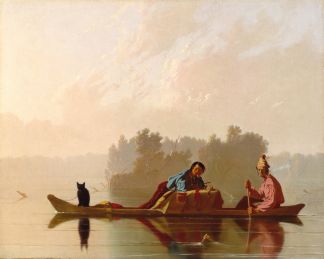
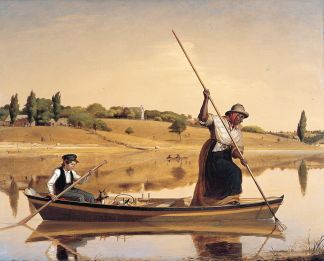
December 3, 2009 at 9:28 AM
Wonderful synopsis of a stunning exhibition. Thank you. We are very pleased to be a part of it, with our painting “Eel Spearing.” The “visual literature” of America is of great interest, especially given the close ties between artists and writers in the 19th century. Thanks for bringing this topic to the fore in grand style.
December 3, 2009 at 10:27 AM
Thank you, Paul, and thanks to all at the Fenimore Art Museum and the New York State Historical Association for the loan of the Mount. Incidentally, readers of this blog will no doubt enjoy a post by Christine Olsen on the Fenimore’s blog, which describes the process of bringing Eel Spearing from Cooperstown to the Met for American Stories. Check it out here!
January 2, 2010 at 4:58 PM
I thoroughly enjoyed “American Stories” on the last day of 2009. I was particularly excited when I read the caption for “The Picnic Grounds” by John Sloan. While I didn’t have a hint as to what park the painting depicts when first gazing at it, I quickly learned that the park was located in Bayonne, New Jersey, my childhood home. I probably played in that park!
January 2, 2010 at 7:54 PM
Thanks for the insight into some of the interesting paintings in the exhibit, and for the parallels to the National Parks documentary.